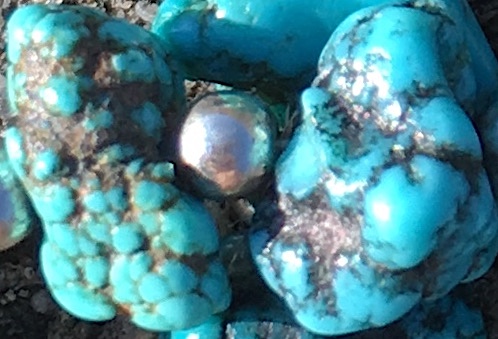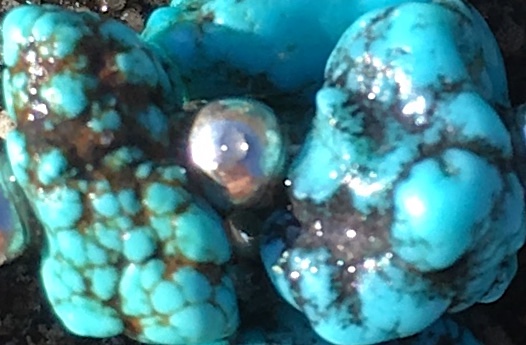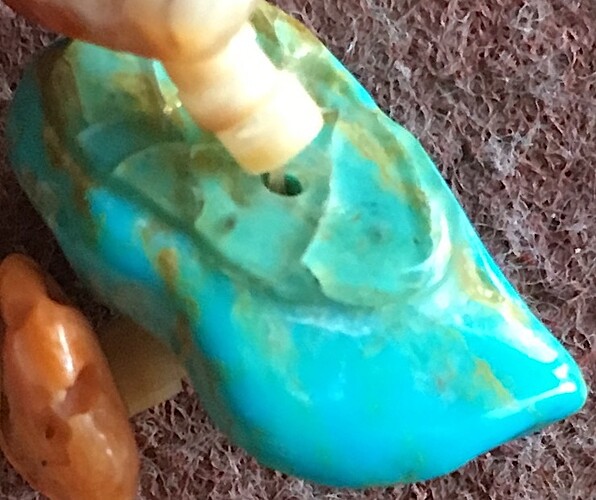Lately i’ve been finding some turquoise nugget beads in my area. Besides ‘brought from America by an elderly lady years ago’ there’s no provenance. I like the way they look and am starting to think that these could be natural. This because the deepest crevices in the matrix look really dry and when i wet them they seem to soak up the water and turn darker in color. Also two beads broke when i held them a bit tight between thumb and index finger and when i re-drilled one there was no funny smell or anything. I’m on some sort of quest where i want to be able to tell the difference between natural and stabilized and was wondering if these characteristics could point to (probably) natural turquoise? I’m interested to hear others’ opinions.


2 Likes
Hi @Bluegreen. The stones in the photo do look like they could be natural. The nugget on the left looks like Kingman, and the one on the right looks like either Sleeping Beauty or Kingman.
Stabilized or treated stone will usually have a chemical plastic odor when drilled. A quick test is to very, very, briefly pass the flame from a butane lighter over the stone (butane is odorless when ignited, so doesn’t have a smell of its own). If resin treated very often you’ll get a faint but unmistakeable chemical odor. To learn to recognize the smell, try this with a stone you know is treated, and take a whiff.
Other indications are color, finish. and clear resiny areas within the matrix. Treated stones which are not carefully cut to remove visible resin will sometimes have obvious signs that it has been resin treated. Treated stone will also tend to take on shine and high luster very quickly owing to the qualities of the resins used to treat them.
There are lots of ways to treat turquoise. In order of expense, from oils, waxes, and washes, to (most common) infused resins, and even chemical enhancement to deepen the color of the stone without significantly altering the chemical makeup (this is much harder to detect).
Your best tools are experience and a good eye. If you’re really serious about it, I also recommend picking up some lapidary equipment to slab, cab, and finish polish the stones yourself. Once you’ve cut and cabbed a few batches of natural and treated turquoise you’ll get a very good feel for what’s what.
6 Likes
Thank you so much for your detailed reply @mmrogers ! It really helps a lot and i’m going to get me a butane lighter asap to be able to do the test that you mentioned.
I sometimes wonder if the residue in the photo below is because the stone wasn’t carefully cut to remove visible resin like you explained (or if it might be glue from the dopping process that wasn’t removed properly).
There’s really a ton that i have to learn, but i like everything about it and find it a bit addictive even  I’ve been cutting and polishing with a dremel tool lately and would love to get some proper lapidary equipment, but it’s quite rare to find it where i live. I guess the dremel will do for now and at some point something good will probably turn up locally though.
I’ve been cutting and polishing with a dremel tool lately and would love to get some proper lapidary equipment, but it’s quite rare to find it where i live. I guess the dremel will do for now and at some point something good will probably turn up locally though.
2 Likes
Good example. That’s literally a puddle of resin on the surface. If properly treated, the resin will have completely permeated the stone through and through. With or without the resin blob, a practiced eye will see immediately that this stone is treated.
5 Likes
Thanks again @mmrogers , your comments are of tremendous help!
1 Like
Happy to be of assistance.
1 Like


